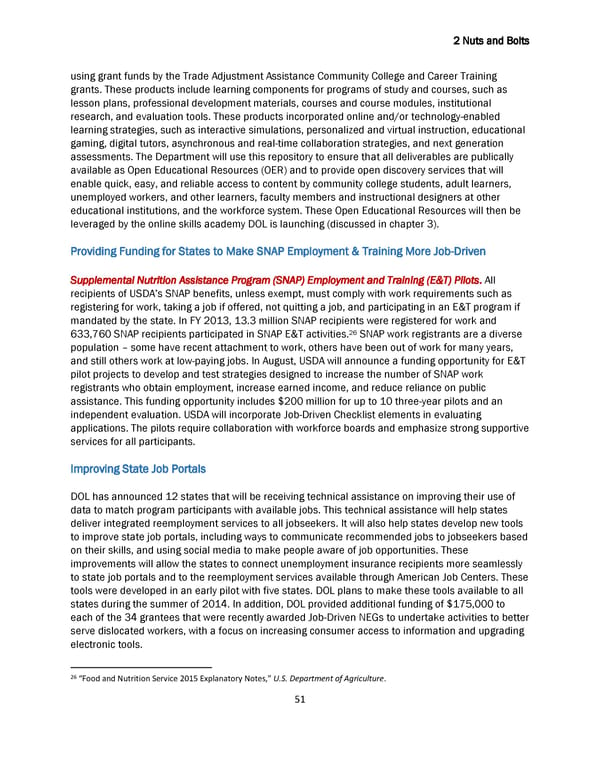2 Nuts and Bolts using grant funds by the Trade Adjustment Assistance Community College and Career Training grants. These products include learning components for programs of study and courses, such as lesson plans, professional development materials, courses and course modules, institutional research, and evaluation tools. These products incorporated online and/or technology-enabled learning strategies, such as interactive simulations, personalized and virtual instruction, educational gaming, digital tutors, asynchronous and real-time collaboration strategies, and next generation assessments. The Department will use this repository to ensure that all deliverables are publically available as Open Educational Resources (OER) and to provide open discovery services that will enable quick, easy, and reliable access to content by community college students, adult learners, unemployed workers, and other learners, faculty members and instructional designers at other educational institutions, and the workforce system. These Open Educational Resources will then be leveraged by the online skills academy DOL is launching (discussed in chapter 3). Providing Funding for States to Make SNAP Employment & Training More Job-Driven Supplemental Nutrition Assistance Program (SNAP) Employment and Training (E&T) Pilots. All recipients of USDA’s SNAP benefits, unless exempt, must comply with work requirements such as registering for work, taking a job if offered, not quitting a job, and participating in an E&T program if mandated by the state. In FY 2013, 13.3 million SNAP recipients were registered for work and 26 633,760 SNAP recipients participated in SNAP E&T activities. SNAP work registrants are a diverse population – some have recent attachment to work, others have been out of work for many years, and still others work at low-paying jobs. In August, USDA will announce a funding opportunity for E&T pilot projects to develop and test strategies designed to increase the number of SNAP work registrants who obtain employment, increase earned income, and reduce reliance on public assistance. This funding opportunity includes $200 million for up to 10 three-year pilots and an independent evaluation. USDA will incorporate Job-Driven Checklist elements in evaluating applications. The pilots require collaboration with workforce boards and emphasize strong supportive services for all participants. Improving State Job Portals DOL has announced 12 states that will be receiving technical assistance on improving their use of data to match program participants with available jobs. This technical assistance will help states deliver integrated reemployment services to all jobseekers. It will also help states develop new tools to improve state job portals, including ways to communicate recommended jobs to jobseekers based on their skills, and using social media to make people aware of job opportunities. These improvements will allow the states to connect unemployment insurance recipients more seamlessly to state job portals and to the reemployment services available through American Job Centers. These tools were developed in an early pilot with five states. DOL plans to make these tools available to all states during the summer of 2014. In addition, DOL provided additional funding of $175,000 to each of the 34 grantees that were recently awarded Job-Driven NEGs to undertake activities to better serve dislocated workers, with a focus on increasing consumer access to information and upgrading electronic tools. 26 “Food and Nutrition Service 2015 Explanatory Notes,” U.S. Department of Agriculture. 51
 Biden Ready to Work White Paper 7/22/14 Page 50 Page 52
Biden Ready to Work White Paper 7/22/14 Page 50 Page 52